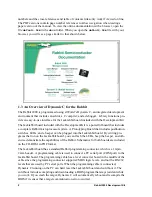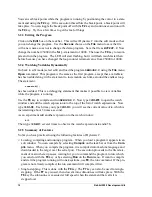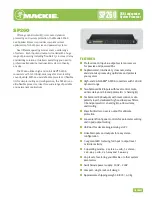
Getting Started Manual
13
•
Setting break points. The
F2
key is used to turn on or turn off (toggle) a break point at
the cursor position if the program has already been compiled. You can set a break point
if the program is paused at a break point. You can also set a break point in a program
that is running at full speed. This will cause the program to break if the execution
thread hits your break point.
•
Watch expressions. A watch expression is a C expression that is evaluated on command
in the watch window. An expression is basically any type of C formula that can include
operators, variables and function calls, but not statements that require multiple lines
such as for or switch. You can have a list of watch expressions in the watch window. If
you are single-stepping, then they are all evaluated on each step. You can also com-
mand the watch expression to be evaluated by using the
<ctrl-U>
command. When a
watch expression is evaluated at a break point, it is evaluated as if the statement was at
the beginning of the function where you are single-stepping. If your program is running
you can also evaluate watch expressions with a
<ctrl-U>
if your program has a
run-
watch()
command that is frequently executed. In this case, only expressions involv-
ing global variables can be evaluated, and the expression is evaluated as if it were in a
separate function with no local variables.
3.3 Cooperative Multitasking
Cooperative multitasking is a convenient way to perform several different tasks at the
same time. An example would be to step a machine through a sequence of steps and at the
same time independently carry on a dialog with the operator via a human interface. Coop-
erative multitasking differs from a different approach called preemptive multitasking.
Dynamic C supports both types of multitasking. In cooperative multitasking each separate
task voluntarily surrenders its compute time when it does not need to perform any more
activity immediately. In preemptive multitasking control is forcibly removed from the
task via an interrupt.
Dynamic C has language extensions to support multitasking. The major C constructs are
called costatements, cofunctions, and slicing. These are described more completely in the
Dynamic C Reference Manual. The example below, sample program
DEMOJR3.C
, uses
costatements. A costatement is a way to perform a sequence of operations that involve
pauses or waits for some external event to take place. A complete description of costate-
ments is in the Dynamic C Reference Manual. The
DEMOJR3.C
sample program has two
independent tasks. The first task flashes LED DS4 once a second. The second task uses
button S1 on the Prototyping Board to toggle the logical value of a virtual switch,
vswitch
, and flash DS1 each time the button is pressed. This task also debounces button
S1.
Содержание 2000
Страница 1: ...Rabbit 2000 Microprocessor Development Kit Getting Started 010118 D...
Страница 4: ...Rabbit 2000 Development Kit...
Страница 9: ...4 Rabbit 2000 Development Kit...
Страница 21: ...16 Rabbit 2000 Development Kit...
Страница 35: ...30 Rabbit 2000 Development Kit...
Страница 36: ...Getting Started Manual Schematics...
Страница 38: ...B NONE B NONE...
Страница 39: ...B NONE B NONE...
Страница 41: ...B NONE B NONE...
Страница 43: ......
















































